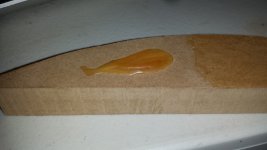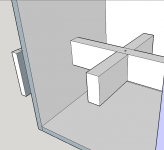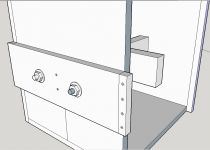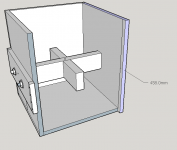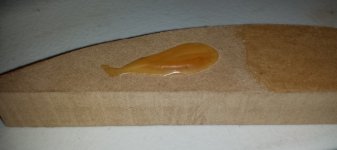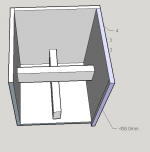nicasiox - as I think Ben is attempting to ask - what exactly will you be carpeting, and what type of carpet? A buddy of mine who's been a car installer for over 30yrs uses 3M or such spray contact for trunk liner and similar thinner carpet materials. For thicker materials, I'd be inclined to use heavy duty flooring mastic and staples.
All the braces are useful, some of them are intended to act as a link between the MDF faces, so theres no need to screw the mdf edges, even if it was plywood, I would use those battens, they give extra support to corners ...
The corners are the strongest part of any cabinet even without bracing. Use the best adhesive you can buy and you don't need to reinforce the corners. They will already be structurally sound and stronger than the material the box is made from.
Also, I've read studies that indicate that corner battens, as you've shown, cause more internal reflections that can be audible. You don't need them and they can be a detriment. Dump them.
I've read studies that indicate that corner battens, as you've shown, cause more internal reflections that can be audible. You don't need them and they can be a detriment. Dump them.
Even for sealed enclosures? I am doing (2) 2.3sf sealed enclosures, one of them have all the battens glued together. I don't think it would be a problem using them as corners, the enclosure is really big and battens represent a minimal mass. Battens did a good work because I am working with MDF, and I have observed how it's not convenient using screws, I mean, MDF can split very easily. Anyway I maybe won't use battens in the second enclosure, which is just glued and ready to receive the battens, can think to insert some dowels instead and make what I thought before, making a cross with zinc threaded rods, washers and nuts. By the way, I just changed the mounting hole size, I made for 15" speaker, which is more convenient for the enclosure size.
Talking about glues, I tried titebond 2 and 3 before, yesterday I gave a chance to titebond 1 (classic) and I am really impressed how it look once dried. Take a look at this, it feels just like epoxy, very very hard, just as a rock.
Attachments
nicasiox - as I think Ben is attempting to ask - what exactly will you be carpeting, and what type of carpet? A buddy of mine who's been a car installer for over 30yrs uses 3M or such spray contact for trunk liner and similar thinner carpet materials. For thicker materials, I'd be inclined to use heavy duty flooring mastic and staples.
I was asking for external carpeting, will make a little sample with wood glue and see how well it make it.
As I am planning experimenting and making several good solid enclosures, I have been thinking in what you guys said before about I was using too many battens, I just see how they...
 are a pain, they require lots of glue beside accuracy cutting, making a dirty job, if I am making several boxes, I better don't use them, I mean, I won't use them in every corner anymore, if I use mdf I simply will use some 5/16 dowels or box joints (in case I build a box joint jig), if plywood I simply can trust in simply using screws, what I still I am thinking about, is in putting a central cross made of 2x4 lumber (which actually is 1.5x3.5"), that cross will connect every wall at the center, still not sure if bottom as well... So in the center part, inside, I will have the cross, which will connect with the four main walls, and with an external bracing that I kept (made of 3/4 plywood), just because for me looks cool with some bolts, washers and nuts, and I got additional reinforcement. What do you think about these final pics? do you think that cross should also connect the bottom part? will it make the difference? because I was planning just bracing the middle part of the structure and nothing else, at the top, the mounting hole holds two wood layers, plus the cover, which also will reinforce that upper part (3 wood layers at the top, 3/4"x3), need opinions about it.
are a pain, they require lots of glue beside accuracy cutting, making a dirty job, if I am making several boxes, I better don't use them, I mean, I won't use them in every corner anymore, if I use mdf I simply will use some 5/16 dowels or box joints (in case I build a box joint jig), if plywood I simply can trust in simply using screws, what I still I am thinking about, is in putting a central cross made of 2x4 lumber (which actually is 1.5x3.5"), that cross will connect every wall at the center, still not sure if bottom as well... So in the center part, inside, I will have the cross, which will connect with the four main walls, and with an external bracing that I kept (made of 3/4 plywood), just because for me looks cool with some bolts, washers and nuts, and I got additional reinforcement. What do you think about these final pics? do you think that cross should also connect the bottom part? will it make the difference? because I was planning just bracing the middle part of the structure and nothing else, at the top, the mounting hole holds two wood layers, plus the cover, which also will reinforce that upper part (3 wood layers at the top, 3/4"x3), need opinions about it.2x4 cross takes about 0.084 volume feet, total space with no cross is about 2.3sf
Attachments
Last edited:
Did we need to see a
Your cross is much better than a dowel.
Gives more area to glue the side panel to the end grain of the cross. And allows many screws into the end grain for a stronger tension joint.
A dowel works reasonably in compression, but does virtually nothing in tension, because the glued joint is simply not strong enough to resist pressure inside the cabinet.
The two braces don't need to intersect. They can pass each other and still give adequate bracing effect.
detail of a splodge of glue?2,048px × 1,152px
Your cross is much better than a dowel.
Gives more area to glue the side panel to the end grain of the cross. And allows many screws into the end grain for a stronger tension joint.
A dowel works reasonably in compression, but does virtually nothing in tension, because the glued joint is simply not strong enough to resist pressure inside the cabinet.
The two braces don't need to intersect. They can pass each other and still give adequate bracing effect.
Attachments
Last edited:
Did we need to see a detail of a splodge of glue?
Your cross is much better than a dowel.
Gives more area to glue the side panel to the end grain of the cross. And allows many screws into the end grain for a stronger tension joint.
A dowel works reasonably in compression, but does virtually nothing in tension, because the glued joint is simply not strong enough to resist pressure inside the cabinet.
The two braces don't need to intersect. They can pass each other and still give adequate bracing effect.
I did not understand what you meant about the glue, I just wanted to show it like, hey, have you seen this glue before, its awesome.
You don't need a dado. Just move the two timbers by half a depth each and they then miss each other.
They are still close enough to the centres of the panels.
Remember a Member said some posts ago that moving the brace off centre can work better than on centre?
Yeah, I remember that message, but I am not sure if I did understand it. So you say that this way is best? (picture below) I put them vertically because waves travel up to down, so I dont know how bad can be increasing bracing impact surface.
Attachments
Yes but.... a half-inch hardwood dowel has all the tension and compression strength you need. In keeping with your woodworking sale, I'd anchor the dowels in a 2x2 wood block and need nothing but to slop on some glue. No precision cuts, no planning before rest of box is done. Low weight.
B.
B.
A dowel across the gap between the panels can take compression when the negative pressure pulls the panels towards each other.
The dowel cannot provide any tension force for the condition when the positive pressure pushes the panels apart.
One has to engineer a method of transferring the panel pull movement into the brace.
Despite your repeated advice to use a dowel, only now in post 50 have you indicated that you finally recognise that some engineering is required to make tension work.
The dowel cannot provide any tension force for the condition when the positive pressure pushes the panels apart.
One has to engineer a method of transferring the panel pull movement into the brace.
Despite your repeated advice to use a dowel, only now in post 50 have you indicated that you finally recognise that some engineering is required to make tension work.
The dowel cannot provide any tension force for the condition when the positive pressure pushes the panels apart.
Are you kidding or were you talking about balsa wood?
B.
I feel stuck now with all this and going nowhere, I think that that massive cross (still light) with the dado is all I need, it has the advantage that it is about 90mm high, so it will cover good area in all walls, and external bracing will be placed a little higher than center, giving support more specifically to upper area, there I am not limited for mounting depth, which I need to keep it about 9".
If you had no bracing it wouldn't be perceptible in the least to the sound with a box your size. Stop fretting over it. A bigger box is what you need.*
B.
*As I type this, I am playing St. Saens Organ Sym (the finale, Murray recording) with one hand on the walls of my box and it is true you can feel just a tiny bit of vibration coming through the MDF... so I know what I am talking about; the colouring introduced by a bit of wall vibration is trivial compared to the distortion of the driver itself
B.
*As I type this, I am playing St. Saens Organ Sym (the finale, Murray recording) with one hand on the walls of my box and it is true you can feel just a tiny bit of vibration coming through the MDF... so I know what I am talking about; the colouring introduced by a bit of wall vibration is trivial compared to the distortion of the driver itself
Last edited:
Well but what if I put a very powerful subwoofer, for example 1 or even 2KW, at these levels I imagine like the crossed bracing would be convenient, specially on sealed enclosure, which the pressure is superior. I hope to experiment in the short term with this, have only tried ported enclosures before and want to make a good enclosure to play with.
If you had no bracing it wouldn't be perceptible in the least to the sound with a box your size. Stop fretting over it. A bigger box is what you need.*
B.
*As I type this, I am playing St. Saens Organ Sym (the finale, Murray recording) with one hand on the walls of my box and it is true you can feel just a tiny bit of vibration coming through the MDF... so I know what I am talking about; the colouring introduced by a bit of wall vibration is trivial compared to the distortion of the driver itself
You posted this idea earlier on in this thread, at which I reacted in post 20 where I explained that (I think) this idea is wrong. Please comment on post 20 if you want to defend this idea.A dowel across the gap between the panels can take compression when the negative pressure pulls the panels towards each other.
The dowel cannot provide any tension force for the condition when the positive pressure pushes the panels apart.
Last edited:
The dowel or rod can resist compression.Stiffness and strength are two different things. For a subwoofer you need stiffness. Strains are small, so the stiffness is constant; it does not depend on whether the rod is loaded in compression or tension.
It does nothing to resist tension. The cabinet expands due to internal air pressure and the rod just sits there floating with air gap/s at it's ends.
The brace has to ATTACH to the panels to carry both tension AND compression.
I too have never seen a cabinet fail due to the pressure exerted by the driver. Why was it necessary to introduce this?Yield strength is not relevant for subwoofers, I have never seen a box get damaged by the air pressure of a woofer.
Last edited:
The dowel or rod can resist compression.
It does nothing to resist tension. The cabinet expands due to internal air pressure and the rod just sits there floating with air gap/s at it's ends.
AndrewT would be completely correct if we were building 20,000* years ago, before humankind discovered glue.
What could he ever have been thinking?
Ben
*just an estimate
- Status
- This old topic is closed. If you want to reopen this topic, contact a moderator using the "Report Post" button.
- Home
- Loudspeakers
- Subwoofers
- Five hole bracing for sealed enclosure.
